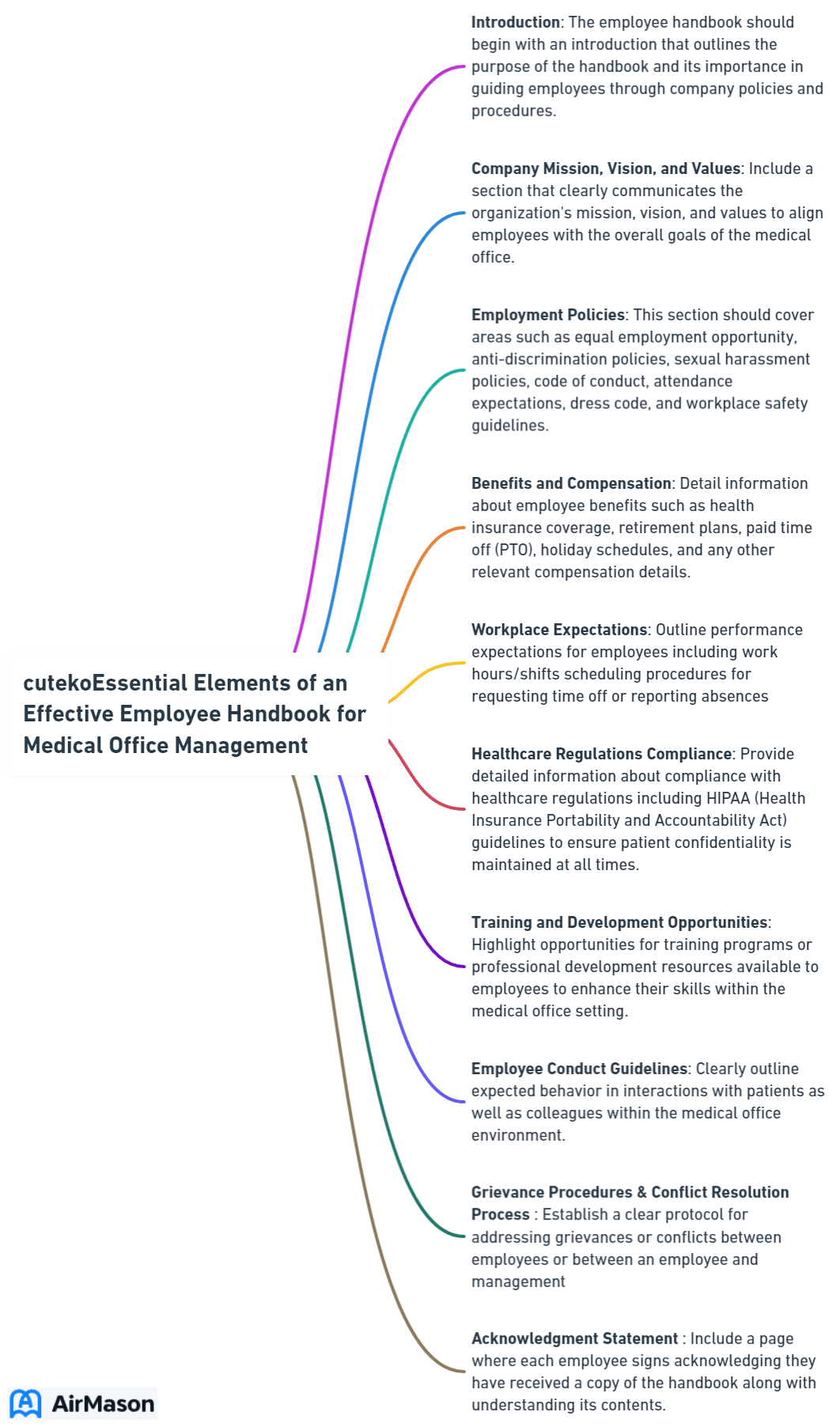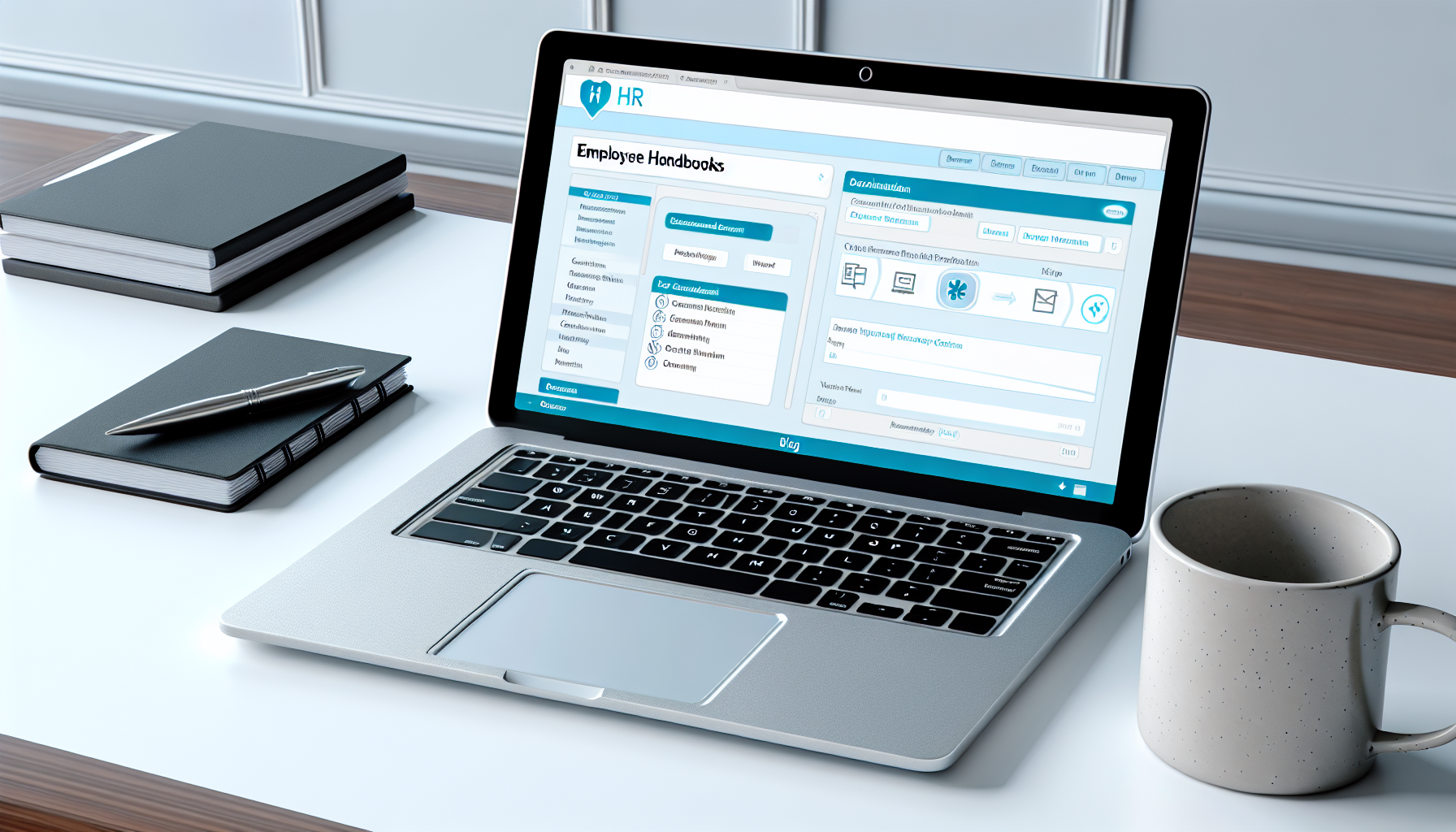
If you are developing an employee handbook for medical office, it’s essential to include key policies that meet healthcare regulations and foster a well-informed, competent staff. Our guide provides a streamlined approach to constructing your Employee Handbook for Medical Office with must-have sections on compliance, roles, and workplace ethics, equipping you with the tools to create a document that resonates with your team’s needs and upholds industry standards.
Key Takeaways
- A medical office employee handbook is essential for compliance with legal requirements, clarity in roles and responsibilities, and providing a guide for employees on workplace conduct and expectations.
- The handbook should be customized and well-structured to reflect the specific practices and procedures of a medical office, including detailed components such as employment policies, job-specific roles, and safety protocols.
- Regular updates and use of HR software are critical for the successful implementation and management of the employee handbook, ensuring it remains a relevant, insightful, and compliant resource for all staff.
Employee Handbook Adoption
Employee handbook adoption is a crucial process for any organization seeking to establish clear guidelines and expectations for its workforce. When implementing an employee handbook adoption strategy, it’s essential to communicate the purpose and benefits of the handbook to all employees. This ensures understanding and buy-in across the board. Additionally, soliciting feedback from employees during the creation or revision of the handbook can enhance its relevance and effectiveness. Once the handbook is finalized, thorough training sessions should be conducted to familiarize employees with its contents and policies. Regular updates and reviews of the handbook are also necessary to keep it aligned with evolving company culture and legal requirements.
Creating a Comprehensive Medical Office Employee Handbook

The importance of an employee handbook is magnified in medical offices. Given the unique challenges and stringent regulations in the healthcare sector, it’s crucial to have a comprehensive document that encapsulates the intricacies of medical practices. A well-crafted medical office employee handbook not only ensures compliance with legal requirements but also caters to the sector’s unique challenges through clear communication.
Imagine it as a reference guide that employees turn to understand their rights and responsibilities, including:
- Dress code
- Confidentiality
- Attendance
- Code of conduct
It offers an effective way to ensure employees understand their roles, prevent misunderstandings, provide legal protection, and establish clear expectations, all while adhering to applicable laws, including federal laws.
Additionally, it helps newcomers familiarize themselves with the culture and expectations of the practice, promoting a seamless integration into their roles.
Importance of a Customized Employee Handbook
In a sector as intricate as healthcare, a one-size-fits-all approach to employee handbooks does not suffice. The unique requirements and challenges of each healthcare practice, including health insurance, underscore the need for a customized employee handbook. A handbook tailored to the medical office ensures that everyone understands the boundaries of acceptable behavior and performance, fostering a harmonious and productive workplace.
Moreover, a customized employee handbook helps establish trust between employers and employees by setting clear guidelines and policies. It serves as the introductory guide for new hires, outlining the values, expectations, and procedures of the healthcare practice. In essence, a customized handbook acts as a beacon, guiding employees through their professional journey in the medical office.

Benefits of a Well-Structured Employee Handbook
The structure and organization of an employee handbook hold equal importance as its content. A well-structured handbook provides clear guidelines and policies, contributing to a positive and productive work environment. It serves as a shield, offering legal protection to the healthcare practice by communicating expectations and behavior standards, thus safeguarding the organization from potential legal liabilities.
Significantly, comprehensive employee handbooks are associated with lower turnover rates, highlighting their impact on employee engagement. Therefore, it’s no surprise that improved communication and legal protection are among the key benefits of a well-structured employee handbook.
Key Components of a Medical Office Employee Handbook

Crafting a comprehensive medical office employee handbook requires a keen understanding of its key components. These components serve as the foundation of the handbook, offering clarity and ensuring that everyone understands their specific duties and responsibilities.
The handbook should cover a wide range of topics, including:
- Employment policies and procedures
- Workplace conduct
- Job-specific roles
- Safety protocols
Each of these components contributes significantly to shaping the work culture, promoting professionalism, and safeguarding staff in a medical office.
Employment Policies and Procedures
One of the key components of a medical office employee handbook is the articulation of employment policies and procedures, which can also be found in an employee manual. These guidelines cover a broad spectrum, promoting fairness by prohibiting discrimination based on protected characteristics, as outlined in the Equal Opportunity Policy and in accordance with employment laws.
A critical aspect of these policies is the Anti-Harassment Policy, which sets clear guidelines for preventing and responding to harassment, ensuring a safe and respectful working environment. The handbook also elaborates on:
- stringent regulations on drug and alcohol use
- social media and Internet usage guidelines
- other miscellaneous employment policies such as work schedules and processes for handling internal grievances.
Furthermore, the handbook outlines benefits and leave policies, providing details on entitlements, rights, and responsibilities concerning various types of leave, including vacation, paid time off, and other employee benefits.
Enterprise Car Rental Employee Handbook
The Enterprise Car Rental Employee Handbook serves as a comprehensive guide for employees, outlining company policies, procedures, and expectations. From customer service protocols to safety regulations, the handbook provides essential information to ensure that employees understand their roles and responsibilities within the organization. New hires are typically required to review and acknowledge receipt of the handbook, which serves as a valuable resource throughout their employment journey. By adhering to the guidelines outlined in the handbook, employees can contribute to the overall success and professionalism of the Enterprise Car Rental team.
Workplace Conduct and Professionalism
Workplace conduct and professionalism form another crucial component of the employee handbook. Medical office employees, as healthcare providers, should uphold a professional demeanor with patients, colleagues, and positively represent the medical business. The handbook provides guidelines for appropriate professional conduct, including conflicts of interest, the acceptance of gifts, and maintaining personal integrity.
Dress code policies, which reflect the medical office’s professional image and respect the diverse cultural and religious beliefs of employees and patients, are also a part of this section. Punctuality, attendance, and clear procedures for reporting absences are emphasized, as these elements are crucial to maintaining productivity and workflow. The handbook also outlines the formal processes in place for filing grievances to address workplace violence and conflicts, underlining the practice’s commitment to employee well-being.
Job-Specific Roles and Responsibilities
An impactful medical office employee handbook should encompass detailed job descriptions, offering clarity on distinct duties and responsibilities. This not only ensures that everyone is aware of their specific roles but also helps in setting clear expectations.
The handbook should also detail the following:
- Training and development opportunities available to staff, such as on-the-job training, continuing education, certification programs, and mentorship programs
- Detailed performance evaluations
- Technology usage guidelines
- The process for assigning tasks
These topics are covered in this section.
Safety and Emergency Protocols
Safety and emergency protocols are vital elements of a medical office employee handbook. Regular inspections and a clean workspace are essential to minimize the risk of fire and identify potential fire hazards. The handbook should provide comprehensive fire safety training, including the proper usage of fire extinguishers, the location of fire exits, and maintaining calm during evacuations.
Conducting regular fire drills helps familiarize employees with emergency evacuation procedures and improve overall safety. The handbook should also include a detailed emergency evacuation plan, with specific escape routes, assembly points, and assistance procedures for those with special needs. With well-defined safety and emergency procedures in place, the workplace is well-equipped for emergencies, ensuring a secure office environment.
Implementing and Updating the Employee Handbook

After crafting the employee handbook, the subsequent step is to guarantee its efficient implementation and routine updates. Providing precise and easily understandable policies and procedures is crucial for implementation, as it ensures that the handbook remains a relevant and valuable resource for employees.
Keeping the employee handbook remains up to date is equally important. An outdated handbook can lead to confusion and non-compliance with current laws, making regular updates a necessity. The use of employee handbook software can aid in tracking employee acknowledgments, ensuring policy understanding, and compliance.
Launching the Employee Handbook
The roll-out of a new employee handbook holds great significance for any organization. It requires a formal announcement to all staff, outlining the handbook’s role in promoting consistency, fairness, and emphasizing its importance in fostering a positive work environment.
The handbook should be easily accessible, provided in a digital format, or through an employee portal or intranet. Hosting a staff meeting or training session can offer a comprehensive overview of the handbook, allowing employees to clarify any questions and address immediate concerns.
Implementing employee handbook software can streamline the onboarding process and offer analytics to monitor and track employee engagement with the handbook, providing valuable insights into employee behavior.
Regular Updates and Compliance Checks
Ongoing review and modifications are necessary to mirror changes in practices, policies, or regulations, and to maintain alignment with legal requirements and industry standards. This process should involve:
- Management
- Periodically review financial and mission alignment
- Consider the impact on employees
- End with a defined communication strategy.
The expertise of HR experts or legal counsel can be invaluable in auditing the employee handbook to identify the need for updates and to ensure ongoing legal compliance. Employee handbooks should also include forms for employees to voice concerns and mechanisms to capture employee acknowledgment of handbook updates, promoting fairness and consistency.
Utilizing HR Software for Employee Handbook Management

The introduction of HR software has transformed the management of employee handbooks. HR software provides a centralized platform that streamlines the customization, creation, and distribution of company policies and guidelines.
Such software often includes features such as:
- a centralized repository
- version control
- policy templates
- customization options
- search functionality
- collaboration tools
- compliance updates
- accessibility
- mobile support
- analytics
The integration of handbook software into HR processes supports a seamless onboarding experience, ensures consistent communication, and helps maintain alignment with company values and regulations.
Advantages of HR Software
Employing HR software for managing the employee handbook carries numerous benefits. It ensures that every staff member has access to the latest version of the handbook through automatic updates.
Moreover, HR software offers customization options that allow medical offices to tailor the handbook content to fit their specific practices and procedures. The employee handbook experience can be enhanced with interactive features like videos, images, and hyperlinks, which can be easily integrated using HR software, making the handbook an engaging and dynamic resource for employees.
Choosing the Right HR Software
Selecting the apt HR software for managing the employee handbook is a crucial decision. It involves creating a strategy and assembling a cross-disciplinary selection team, involving stakeholders from HR, IT, finance, and potential end-users.
Important considerations include industry-specific templates, ease of use, and features that support real-time collaboration for multiple stakeholders. It’s also essential to evaluate the cost of the software, not just the acquisition price, but also expenses related to data migration, deployment, training, and consulting fees.
Ultimately, the selection should be driven by a vision that goes beyond simply automating existing processes, aiming to find a vendor capable of transforming HR processes in alignment with the organization’s goals.
The Small Business Handbook
The Small Business Handbook serves as an indispensable resource for entrepreneurs navigating the complex landscape of starting and managing a small business. Covering topics ranging from business planning and marketing strategies to financial management and legal considerations, this comprehensive guide offers practical insights and expert advice to help small business owners succeed. Whether you’re launching a new venture or looking to grow your existing business, The Small Business Handbook provides valuable tips, tools, and resources to support your journey towards entrepreneurial success. With its user-friendly format and actionable insights, this handbook is essential reading for anyone seeking to thrive in the competitive world of small business.
Summary
In conclusion, an employee handbook tailored for a medical office is an indispensable tool that promotes effective communication, ensures legal compliance, and fosters a positive work environment. It is a comprehensive document that provides clear guidelines on employment policies, workplace conduct, job-specific roles, and safety protocols. Regular updates and compliance checks ensure the handbook remains up-to-date, and the use of HR software can streamline the customization, creation, and distribution of the handbook. As healthcare practices continue to evolve, so should the employee handbook, reflecting the changes and challenges of the industry while upholding the core values and objectives of the organization.
Frequently Asked Questions
Why do we need a customized employee handbook for medical practices?
A customized employee handbook for medical practices is essential because it helps everyone understand the boundaries of acceptable behavior and performance, fostering a harmonious and productive workplace. It also addresses the unique challenges and regulations in the healthcare sector.
What are the key components of a medical office employee handbook?
The key components of a medical office employee handbook include employment policies, workplace conduct, job-specific roles, and safety protocols. These components provide employees with essential information for their roles and workplace conduct.
How often should an employee handbook be updated?
It is advisable to review and update the employee handbook regularly to align with current practices, policies, regulations, and industry standards. This helps ensure legal compliance and consistency.
What are the benefits of using HR software for managing the employee handbook?
Using HR software for managing the employee handbook ensures that staff members have access to the latest version through automatic updates and offers customization options and interactive features, making it an engaging resource for employees.
How do we choose the right HR software for managing the employee handbook?
You should choose HR software that offers industry-specific templates, is easy to use, and supports real-time collaboration for multiple stakeholders. Additionally, consider the total cost of ownership, including expenses related to data migration, deployment, training, and consulting fees.
Important Disclaimer:
Please be aware that the content on this page has been generated by using artificial intelligence language models and may contain errors, inconsistencies, or outdated information. It is provided as-is without any warranties or guarantees of accuracy.
We strongly recommend using this content as a starting point for further research. We disclaim any liability for damages or losses resulting from the use or reliance on this content.